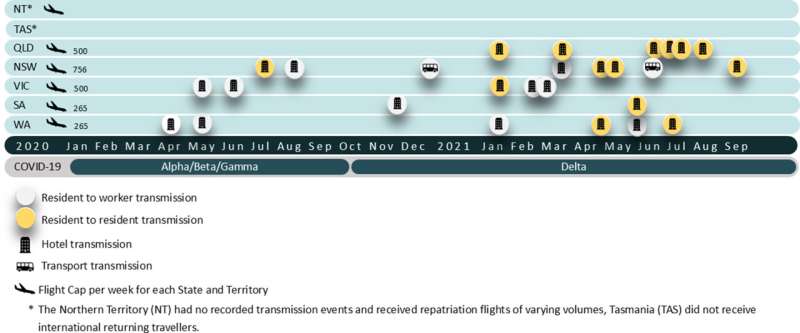This article has been reviewed according to Science X's editorial process and policies. Editors have highlighted the following attributes while ensuring the content's credibility:
fact-checked
trusted source
proofread
Research reveals the gaps in Australia's pre-COVID quarantine planning

New research by Deakin University has found Australia's COVID-19 quarantine response was seriously let down by the failure to prepare and plan for isolation measures beyond home quarantine.
During the height of the pandemic, federal, state and territory governments were managing 22 hastily established quarantine pathways, including the highly contentious hotel quarantine system, but none had been planned for or mentioned in pre-existing emergency management plans.
Associate Professor Stéphane Bouchoucha from Deakin's Center for Innovation in Infectious Disease and Immunology Research (CIIDIR) and the Institute for Health Transformation (IHT) said it was concerning there was no blueprint to manage such a complex choreography of what would turn out to be the quarantine of more than half a million people.
"We had 22 different types of travelers moving through the mandatory quarantine system, from Australians returning home from interstate and overseas, airline crew, sportspeople and entertainers, unaccompanied children and humanitarian evacuees," Associate Bouchoucha said.
"They all had different needs and required different levels of support. Given the speed at which mandatory quarantine needed to be put in place across Australia, it is remarkable there were only 27 reported escapes of the virus into the community."
The article, "Mapping Australia's COVID-19 quarantine cohort journeys," published August 12 in Infection, Disease and Health found the majority of pre-existing pandemic plans assumed a future pandemic would only require voluntary home quarantine.
"As we now know, quarantine was needed in a range of public and private locations, and most of these were operating without a plan or framework to guide staff on the ground, Associate Professor Bouchoucha said.
"Documents updated after COVID-19 still do not acknowledge the complexity of quarantine journeys and operations required during a pandemic and 282 recommendations made by post-pandemic inquiries have not yet been implemented.
"Governments must commit to updated pandemic plans to incorporate multiple quarantine locations.
"The plans need to be exercised regularly with quarantine-specific scenarios that vary in scale and duration to ensure quarantine capabilities are tested and capacity failure points are identified and remediated before the next pandemic.
"Reducing the ad-hoc nature of quarantine journeys is essential to managing the risk across the quarantine system.
"The authority and responsibility for quarantine needs to be clarified. Without a problem custodian, no meaningful preparedness can occur, and fragmentation will persist," Associate Professor Bouchoucha said.
More information: Matiu Bush et al, Mapping Australia's COVID-19 quarantine cohort journeys, Infection, Disease & Health (2024). DOI: 10.1016/j.idh.2024.07.001


















